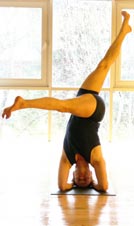Air in the Dynamic Yoga Method
AIR: THE ELEMENT OF RHYTHM
Air qualities are expansion, filling, lightness, rhythm, grace, mobility and thinking. The fundamental expression of air is expansion, opening or exetension, and it is embodied in the technique of pranayama.The arena of air is the thorax, its source is the throat, its medium the joints, and its key the bones. Air is cultivated and expressed by creating space in the joints and organs, particularly the lungs, and creating lightness in action and movement.
The superficial application of air is to develop the capacity to overcome the effect of gravity on the physical body, especially through the practice of inversions and armbalances. The subtle application is to free the mind from rigidity by releasing the breath from all imposition and intention. This is the being or transformation state of pranayama, which results from respiratory spontaneity, and never from control. Establishing air requires rhythm, the sign of its presence is its opposite, silent-stillness. Without rhythm we become locked into deep dualistic patterns of physical, mental and spiritual tension. Without space in the joints we become rigid and dry.
When the integrating dynamics of the bandhas are applied in the whole body (sarvangabandha) it opens (sukham) all the joints while simultaneously stabilising (sthiram) them. Then the body also becomes light and graceful. At the heart of this grace is the effortless activity of the respiratory mechanism. The rhythm of diaphragm and accessory respiratory muscles must be allowed to be a natural expression of the intrinsic wisdom of the body. A wisdom developed through 3,500,000,000 years of trial and error since cellular respiration began in unicellular organisms.
To tamper with the breath from the mind is to meddle with our integrity at the organic roots of our being. Any attempt to directly control the breath during yoga posture practice is not only an imposition, but a profound statement of mistrust in the integrity of the body and life. It not only wastes energy by unncecessarily increasing muscular and mental activity, but also generates the tension that always results from the application of intention.
The breath can only safely be released by recognising and realising the functional unity (yoga) of respiration and motion, that began when locomotion brought life and lungs out of the ocean. Releasing the body from structural distortion is to liberate the breath, without any need for conceptual imposition. This depends especially on the lengthening of the spine. When the ribcage is lifted without pivoting any of the vertebrae, deep muscles in the abdomen engage to anchor our gravity centre. When this lift is held, the spine remains long, the ribcage remains open, and the abdomen remains engaged.
Because of the inherent integrity of the human body, the free and full release of the spine depends upon the integrated activation of the whole body. This involves activating the structural dynamic of the bandhas in the hands and feet, the energetic dynamic in the arms and legs. Then the spine is supported and fulfilled and breathing takes place through the agency of the whole body. Breathing is then transformed indirectly from the whole body. This application of the bandhas in the whole body (sarvangabandha) naturally elicits ujjayi breathing.


